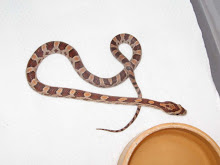Two-headed snakes are not as rare as one might think. This two-headed corn snake, named Thelma and Louise, was at the San Diego Zoo and was responsible for having 15 normal snake offspring before it died. The two-headed monsters of myth may have a basis in reality. Two-headed snakes are rare but not unheard of, and one recently found in Spain is giving scientists an opportunity to study how the anomaly affects their ability to hunt and mate.
This two-headed snake is being studied by scientists in Spain.
The biological curiosity has four eyes and two tongues.
Ladder snake
Grows up to 160 cm long
Found in Southern France, Portugal and Spain
Name comes from the ladder-like lines on the backs of young snakes
Feeds on insects, lizards, small rodents and birds. It also has two sets of fangs, but is not poisonous.
Zoologists at the University of Valencia say the rare reptile can eat using both heads at the same time.
They hope to discover if it has two separate digestive tracts and whether one head is dominant over the other.
The baby ladder snake was found by a farmer in a village in Alicante.
Lucky discovery
It is believed to be a few months old and is lucky to have survived in the wild.
Eating is a slow process and the two heads have been known to fight each other for food.
Other double-headed snakes have been found in Honduras, the United States, Sri Lanka and Argentina.
A two-headed corn snake named Thelma and Louise was kept at San Diego Zoo on the US west coast.
It had 15 normal snake offspring before it died



